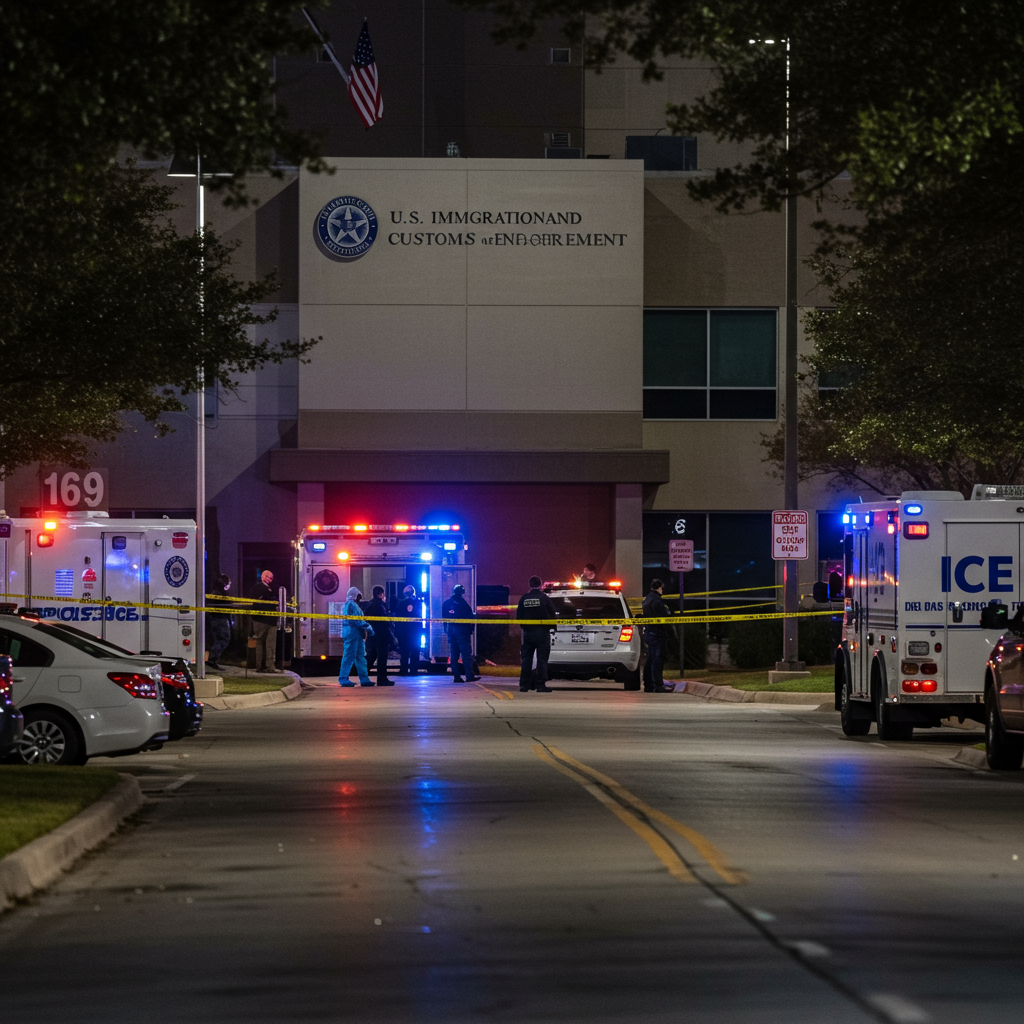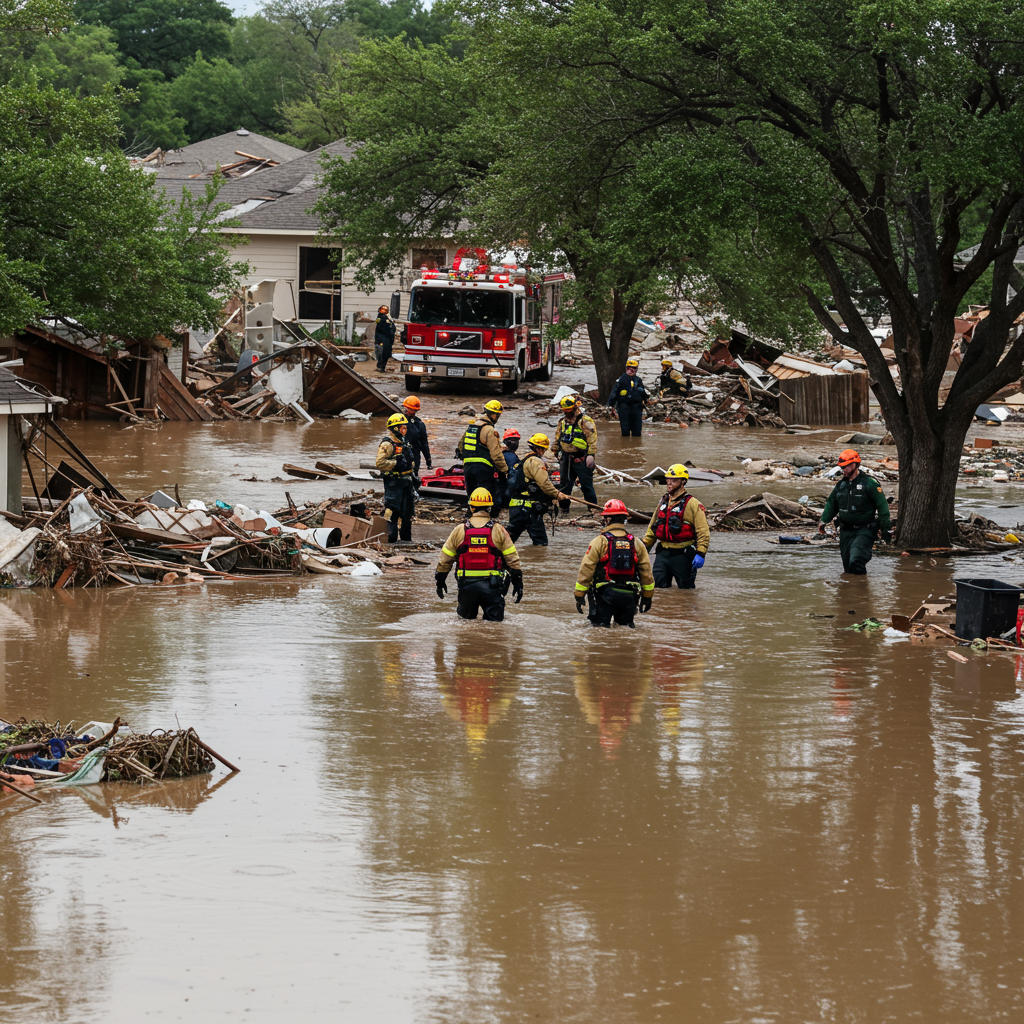The tragic events of September 24, 2025, in Dallas, Texas, sent shockwaves across the nation. An early morning sniper attack at a U.S. Immigration and Customs Enforcement (ICE) facility left two immigration detainees dead and another critically injured. This harrowing incident, classified by federal authorities as “targeted violence” with an “ideological motive,” highlights a dangerous escalation in anti-government sentiment.
This article delves into the details of the Dallas ICE shooting, exploring the timeline of the attack, the identity of the assailant, and the profound reactions from officials and the public. We will also examine the disturbing pattern of threats and violence against ICE facilities, underscoring the complex and often volatile landscape surrounding immigration enforcement.
The Tragic Morning Unfolds at the Dallas ICE Facility
Just after 6:30 a.m. on a Wednesday morning, chaos erupted at the Dallas ICE field office located on North Stemmons Freeway. A sniper, later identified as 29-year-old Joshua Jahn, opened fire from an elevated position on the roof of a nearby law firm building. His targets were ICE detainees being transported or present within a secure entryway, known as a sally port.
Witnesses described a terrifying barrage of gunfire. Arianny Sierra, waiting in her car with her young son for her husband, recounted hearing “like 20 shots in a row” and immediately took cover under her vehicle. Inside the facility, Mayra Robleto, a 71-year-old immigrant, heard the piercing sound of bullets, fearing for her daughter waiting outside.
Dallas police officers responded swiftly to the 8100 block of North Stemmons Freeway around 6:40 a.m. Upon arrival, they discovered multiple victims. Tragically, two of the three detainees shot during the assault succumbed to their injuries, one at the scene and another at a local hospital. The third victim remains in critical condition. Authorities confirmed that no ICE officers or law enforcement personnel were harmed during the attack, though the indiscriminate firing posed a severe threat to everyone present.
Unmasking the Assailant and His Ideological Motive
The suspected shooter, Joshua Jahn, was identified as a 29-year-old man with ties to North Texas and Oklahoma. As agents approached his position on the adjacent building’s roof, Jahn reportedly died from a self-inflicted gunshot wound.
Crucial evidence found near Jahn revealed a disturbing ideological motive behind the Dallas ICE shooting. FBI Director Kash Patel shared images of unspent ammunition marked with “ANTI-ICE” in blue ink, indicating a premeditated act of defiance. FBI Special Agent in Charge Joe Rothrock confirmed these messages, classifying the incident as “an act of targeted violence” stemming from an “ideological” stance against the federal agency.
While law enforcement suggested a clear political motive, Jahn’s brother, Noah Jahn, expressed surprise. He stated that Joshua was not particularly interested in politics and had not voiced strong anti-ICE opinions to his family, describing him as “unique” rather than a political extremist or a “marksman.” Joshua, who had done coding work, was unemployed and planning to move to his parents’ property. His past included a 2015 arrest in Collin County for marijuana possession, where a mugshot was taken.
Investigators also found a car believed to belong to Jahn near the scene. It displayed an enigmatic sign that read: “Radioactive fallout from nuclear formations that’ve passed over these areas more than 2x since 1951.” This detail further shrouded the assailant’s state of mind in mystery, even as the “ANTI-ICE” messages pointed to a clear direction for the investigation.
The Victims: Unarmed Detainees Caught in the Crossfire
A particularly poignant detail of the Dallas ICE shooting is the identity of the victims. Officials confirmed that all three individuals shot were ICE detainees. This fact was reiterated by Department of Homeland Security (DHS) officials and local law enforcement, who deliberately distinguished the victims from agency personnel.
The fatalities of these unarmed detainees drew significant attention. While officials condemned the violence, some politicians and community leaders noted the grim irony of immigrants—often the subject of contentious political debate—being the casualties in an attack ostensibly targeting the agency responsible for their detention. This element added a layer of tragedy and complexity to an already devastating event.
A Broader Pattern: Escalating Threats Against ICE
The Dallas ICE shooting is not an isolated incident. It sadly fits into a disturbing pattern of escalating threats and violence directed at immigration enforcement facilities and personnel. This context underscores the concerns raised by officials regarding the real-world consequences of divisive political rhetoric.
Just two months prior, in early July, the Alvarado ICE Detention Center in Johnson County was ambushed. In that incident, at least 16 individuals, some in military-style clothing, protested and used fireworks against the facility. The situation escalated when an Alvarado police officer responding to vandalism was shot in the neck by Benjamin Song, who was later captured as an FBI Most Wanted suspect. Investigators found AR-style rifles, two-way radios, and body armor, suggesting a highly coordinated “conspiracy.”
More recently, in late August, the very same Dallas ICE facility targeted in this shooting faced a bomb threat. Bratton Dean Wilkinson, 36, was arrested after he arrived at the office claiming to have a bomb in his backpack and displaying what he called a “detonator” on his wrist. These previous incidents paint a clear picture of an increasingly volatile environment for federal immigration agencies and their employees.
Political Fallout and Calls for Temperance
The Dallas ICE shooting immediately ignited a fierce debate among political leaders, underscoring the deeply polarized nature of immigration discourse. Reactions ranged from calls for prayer and patience to accusations of inciting violence.
Dallas Mayor Eric Johnson urged the public to “remain calm” and allow law enforcement to conduct their investigation, emphasizing the need for prayer for the victims’ families. Texas Governor Greg Abbott affirmed the state’s “full support for ICE,” declaring that the shooting “will NOT slow our arrest, detention, & deportation of illegal immigrants.” U.S. Senator Ted Cruz vehemently condemned the “politically motivated violence,” stating, “The rhetoric has to stop.” He linked this incident to other attacks on ICE/CBP in Texas, imploring politicians to cease “demonizing” these agencies and their personnel.
Conversely, some Republican officials, including Homeland Security Secretary Kristi Noem and Vice President JD Vance, directly blamed “far-left” rhetoric for inciting such violence. Noem specifically mentioned comparisons of ICE to “Nazi Gestapo” or “slave patrols” as having “severe consequences.” FBI Director Kash Patel similarly described such events as “despicable, politically motivated attacks against law enforcement.”
However, Democratic Representative Marc Veasey criticized what he perceived as the immediate politicization of the event by some, urging for a lowering of the political temperature. These varied responses highlight the deep divisions within the national conversation about immigration enforcement and the delicate balance between free speech and its potential impact on real-world events.
The Ongoing Investigation and Unanswered Questions
The investigation into the Dallas ICE shooting remains active and ongoing. A multi-agency task force, including the FBI, Dallas Police Department, and Department of Homeland Security, is working “shoulder to shoulder” to piece together the full scope of the incident. While the identity of the shooter and his anti-ICE motive have been established, many questions persist.
Investigators are probing how long the attack might have been planned, Joshua Jahn’s specific motivations beyond the “ANTI-ICE” messages, and any potential connections he might have had to organized extremist groups. The identities of the deceased and injured detainees have not yet been released, out of respect for their families and the ongoing investigation. As officials continue their work, the community and the nation grapple with the implications of this violent act and the broader context of targeted aggression against federal agencies.
Frequently Asked Questions
What exactly happened at the Dallas ICE facility on September 24, 2025?
On the morning of September 24, 2025, a sniper, identified as 29-year-old Joshua Jahn, opened fire from a nearby rooftop into the Dallas ICE facility on North Stemmons Freeway. He targeted a transport van and secure entryway, shooting three ICE detainees. Two of the detainees died from their injuries, and one remains in critical condition. The shooter later died from a self-inflicted gunshot wound. No law enforcement officers were harmed during the incident.
What motivated the Dallas ICE facility shooting?
Federal investigators have classified the Dallas ICE shooting as an act of “targeted violence” with an “ideological motive.” Evidence found near the shooter, including unspent ammunition explicitly marked “ANTI-ICE,” indicates a clear anti-government sentiment directed at the Immigration and Customs Enforcement agency. This aligns with broader concerns expressed by officials about increasingly hostile rhetoric surrounding immigration enforcement policies.
How does the Dallas ICE shooting relate to other incidents targeting immigration enforcement?
The Dallas ICE shooting is part of a concerning trend of violence and threats against federal immigration facilities. This includes a bomb threat at the very same Dallas ICE office in late August and an ambush at the Alvarado ICE Detention Center in July, where an officer was shot. These incidents collectively underscore an escalating pattern of targeted aggression against ICE and other agencies involved in immigration enforcement.



